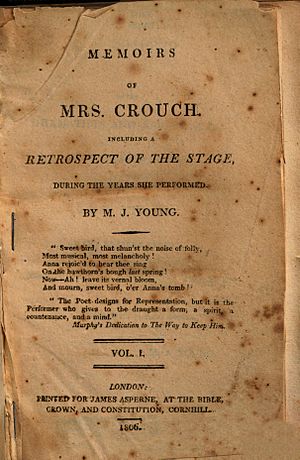Mary Julia Young facts for kids
Quick facts for kids
Mary Julia Young
|
|
|---|---|
| Pen name | A lady; a young lady |
| Occupation | author |
| Language | English |
| Period | Romantic |
| Years active | 1788—1810 |
| Notable works | Memoirs of Mrs. Crouch (1806) |
| Relatives | Edward Young |
|
|
|
Mary Julia Young (who wrote between 1775 and 1810) was a very active writer. She wrote novels, poems, and biographies, and she also translated books. She was busy during the Romantic period, a time when art and literature focused a lot on feelings and nature. Mary Julia Young is interesting because she was a professional woman writer when many books were being produced for a wide audience.
Contents
About Mary Julia Young's Life
We don't know much about Mary Julia Young's personal life, even though she wrote so many books. It seems she might have had money problems. Some of her novels were called "potboilers," which means they were written quickly just to earn money. But she also wrote a really good biography about an actress and other smart and interesting works.
In 1808, she asked for financial help from the Royal Literary Fund, which was a group that supported writers. From her application, we know that she was the last person left in her family. She was also related to a famous poet named Edward Young (who lived from 1683 to 1765).
Mary Julia Young's Writing Journey
Mary Julia Young first started writing poetry. Her first collection of poems, called Genius and Fancy, came out in 1791. It was so popular that it was reprinted and then published again with many more pages. This third edition was special because it was the first time her name, Mary Julia Young, was on the book. Before that, her books were just listed as "by a lady."
She also translated three books from other languages into English. One of these was Lindorf and Caroline (1803), a historical novel by a German author named Benedikte Naubert. Another translation was The Mother and Daughter (1804) by J. B. C. Berthier. Her third translation was of writings by Voltaire, a famous French writer, and was called Voltairiana.
Mary Julia Young wrote many novels, possibly eight or nine. Her novels were often written to sell well. They were sometimes sentimental, meaning they focused on strong emotions. Some were Gothic, which means they had mysterious or spooky elements, like old castles. Others were sensational, full of exciting and dramatic events.
Most of her books were published with her own name on them, partly because being related to Edward Young gave her some fame. However, she published A Summer at Brighton without her name in 1807. This book was very successful and had many reprints. Her next novel, A Summer at Weymouth, was also published anonymously. These two books were likely "scandal novels," meaning they were about gossip or secrets.
Her last novel, The Heir of Drumcondra, was a return to the sentimental style and was published under her own name. Her usual publisher went out of business in 1808, so this book was published by Minerva Press. It was around this time, after a busy writing career, that she needed to ask the Royal Literary Fund for help.
Mary Julia Young was always interested in the theatre. Besides her poems, novels, and translations, she wrote a well-liked biography in 1806 about an actress named Anna Maria Crouch. The book was called Memoirs of Mrs. Crouch.
For a long time, Mary Julia Young was considered one of the "lost" women writers from before Jane Austen. But now, more people are studying her work. Her poetry has been included in collections, and there's growing research about her.
Mary Julia Young's Published Works
Here are some of the books Mary Julia Young wrote or translated:
Poetry
- Horatio and Amanda, a poem. (1788)
- Genius and fancy; or, dramatic sketches. (1791, reprinted 1795)
- Adelaide and Antonine: or the emigrants: a tale (1793)
- Poems. (1798)
Novels
- The family party. (1791) – (This one might not be hers.)
- Rose-mount castle; or, false report. (1798)
- The East Indian, or Clifford Priory. (1799)
- Moss Cliff Abbey; or, The Sepulchral Harmonist. (1803)
- Right and Wrong; or, The Kinsmen of Naples. (1803)
- Donalda, or The Witches of Glenshiel. (1805)
- A Summer at Brighton. (1807) – (Published without her name)
- A Summer at Weymouth, or, The Star of Fashion. (1808) – (Published without her name)
- The Heir of Drumcondra; or, Family Pride. (1810)
Translations
- Lindorf and Caroline; or, The Danger of Credulity. (1803) – (Translated from German)
- The Mother and Daughter. (1804) – (Translated from French)
- Voltairiana. (1805) – (Translated from Voltaire's writings)
Biography
- Memoirs of Mrs. Crouch. Including a Retrospect of the Stage, during the Years she Performed. (1806)
See also
- List of Minerva Press authors
- Mothers of the Novel: 100 Good Women Writers Before Jane Austen


